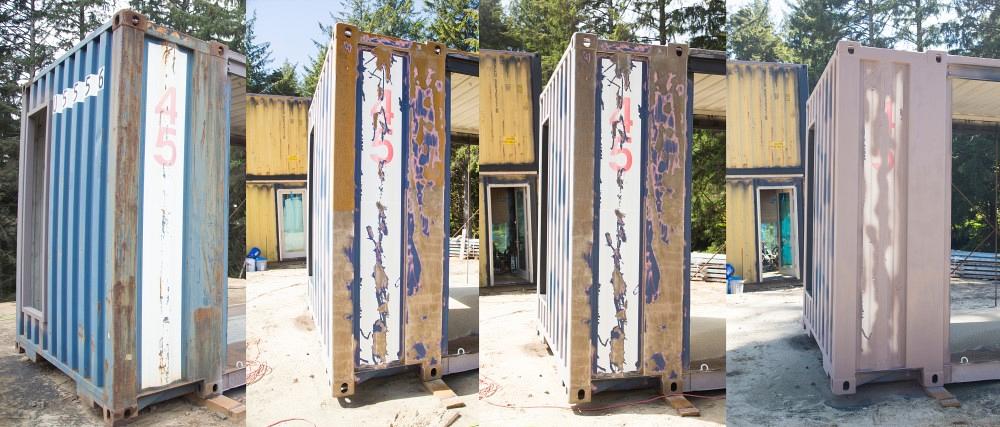- FMA
- The Fabricator
- FABTECH
- Canadian Metalworking
Categories
- Additive Manufacturing
- Aluminum Welding
- Arc Welding
- Assembly and Joining
- Automation and Robotics
- Bending and Forming
- Consumables
- Cutting and Weld Prep
- Electric Vehicles
- En Español
- Finishing
- Hydroforming
- Laser Cutting
- Laser Welding
- Machining
- Manufacturing Software
- Materials Handling
- Metals/Materials
- Oxyfuel Cutting
- Plasma Cutting
- Power Tools
- Punching and Other Holemaking
- Roll Forming
- Safety
- Sawing
- Shearing
- Shop Management
- Testing and Measuring
- Tube and Pipe Fabrication
- Tube and Pipe Production
- Waterjet Cutting
Industry Directory
Webcasts
Podcasts
FAB 40
Advertise
Subscribe
Account Login
Search
Off the Grid: The battle to remove rust from weathered steel shipping containers
Us vs. the rust: Best tools and techniques for getting rid of mild to heavy rust in corrosive environments
- By Jessica P.
- January 23, 2021
Rust: The reaction of iron and oxygen in a catalytic presence of water and/or air moisture.
Living in a place as corrosive as the Oregon coast, rust has become our greatest enemy. We are in a constant battle against it and have tried just about every type of common rust treatment or removal technique possible.
Throughout our experiences on Pacific Pines Ranch with rust management, especially with building our steel shipping container home, we have learned rust's weaknesses. Using the angle grinder, rust converter, and sandblaster, we've conquered our enemy and can confirm which techniques work best with each level of rust.
Generally speaking, there are three kinds of rust: yellow, red, and black. Being located on the Oregon coast, we mainly deal with red rust due to the atmospheric exposure to salt, water, and oxygen. The levels of salt, water, and oxygen are so high that exposed steel can start to rust within hours. Based on the amount of time the steel is exposed to the elements, this can cause three levels of rust: mild, medium, and heavy.
The techniques we use vary based on what level of rust we are fighting against.
MILD RUST
For dealing with mild rust, such as flash rust or surface rust, we use an angle grinder with a wire wheel, angle grinder with a resin sanding disc, and orbital sander. The angle grinder with the wire wheel is the best for uneven surfaces and gives a nice finish when complete.
The angle grinder with the resin sanding disc is the fastest way to remove rust, but the lower the grit of the resin disc, the rougher the finish. The orbiting sander is great for removing rust on flat surfaces and does a great job on the finish, but it's somewhat time consuming. Both sanding options are difficult to use on uneven surfaces because of their rigidness.
All of these tools are easy to find in any hardware store, and they do not require any kind of special equipment to operate--a big consideration when living in a remote area.
MEDIUM RUST
For fighting medium rust, such as pitted, rough-textured rust, we most often use two techniques: an angle grinder with a resin sanding disc/wire wheel, and a dry sandblaster.
The angle grinder with wire wheel works well for this application because it flexes and fits into the pitted areas of the steel, but it can be somewhat time-consuming because of the level of rust being removed. That's why we usually do a few passes with the angle grinder and resin sanding disc first to remove the rust on the flat surfaces, and then we go back and hit it with the angle grinder and wire wheel for the areas the sanding disc can’t reach.

One of the biggest challenges Pacific Pines Ranch ran into while prepping its shipping container house was properly removing rust from the weathered steel. Here are the tools and techniques it found most useful, especially in a corrosive environment like the Oregon coast. Images provided by Pacific Pines Ranch
Overall, the tool that’s fastest and gives the best finish for this application is the dry sandblaster. For this technique, we use a sandblasting siphon gun with aluminum oxide or coal slag as blasting media, along with a 125 –gallon, 150-PSI air compressor. The downside to this technique is that it can be extremely messy and difficult to get the air compressor to remote areas. Also, the material can be expensive and hard to find in a remote area.
HEAVY RUST
Our greatest battle has been with extremely scaly, heavy rust. We have tried close to everything available to the average consumer to overcome this nemesis, and we have found that these two techniques worked best: dry sandblasting and wet sandblasting.
Before I dive into the pros and cons of each technique, I will tell you what technique did not work at all, and that was using a rust converter. Rust converters interact chemically with iron oxides and convert the rust into a black layer. We tried four different kinds, and none of them could overcome this level of rust. While these rust converters can be used successfully on mild or medium rust, our heavy rust was out of their reach.
Dry sandblasting with a siphon gun, aluminum oxide/coal slag, and a 125 –gallon, 150-PSI air compressor works well, but it’s ridiculously time consuming. The only way we have found to fight this level of rust efficiently is with a wet sandblaster.
The wet sandblaster uses a 4,400 –PSI, gas-powered pressure washer with a siphon attachment, plus any kind of sandblasting material. This technique has been our saving grace and has allowed us to remove a vast amount of extreme rust in a short amount of time. The downside is the pressure washer requires access to a pressurized water source, so it can be tricky to use in off-grid applications.
Rust continues to infiltrate our steel, and we continue to keep it at bay while learning new techniques and perfecting old techniques along the way.
Editor's Note: To see more about Pacific Pines Ranch's constant battle against rust, check out YouTube, Facebook, and Instagram.
subscribe now

The Fabricator is North America's leading magazine for the metal forming and fabricating industry. The magazine delivers the news, technical articles, and case histories that enable fabricators to do their jobs more efficiently. The Fabricator has served the industry since 1970.
start your free subscriptionAbout the Author
- Stay connected from anywhere

Easily access valuable industry resources now with full access to the digital edition of The Fabricator.

Easily access valuable industry resources now with full access to the digital edition of The Welder.

Easily access valuable industry resources now with full access to the digital edition of The Tube and Pipe Journal.
- Podcasting
- Podcast:
- The Fabricator Podcast
- Published:
- 04/16/2024
- Running Time:
- 63:29
In this episode of The Fabricator Podcast, Caleb Chamberlain, co-founder and CEO of OSH Cut, discusses his company’s...
- Trending Articles
AI, machine learning, and the future of metal fabrication

Employee ownership: The best way to ensure engagement

Steel industry reacts to Nucor’s new weekly published HRC price

Dynamic Metal blossoms with each passing year

Metal fabrication management: A guide for new supervisors

- Industry Events
16th Annual Safety Conference
- April 30 - May 1, 2024
- Elgin,
Pipe and Tube Conference
- May 21 - 22, 2024
- Omaha, NE
World-Class Roll Forming Workshop
- June 5 - 6, 2024
- Louisville, KY
Advanced Laser Application Workshop
- June 25 - 27, 2024
- Novi, MI




























